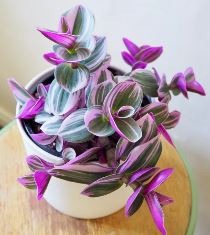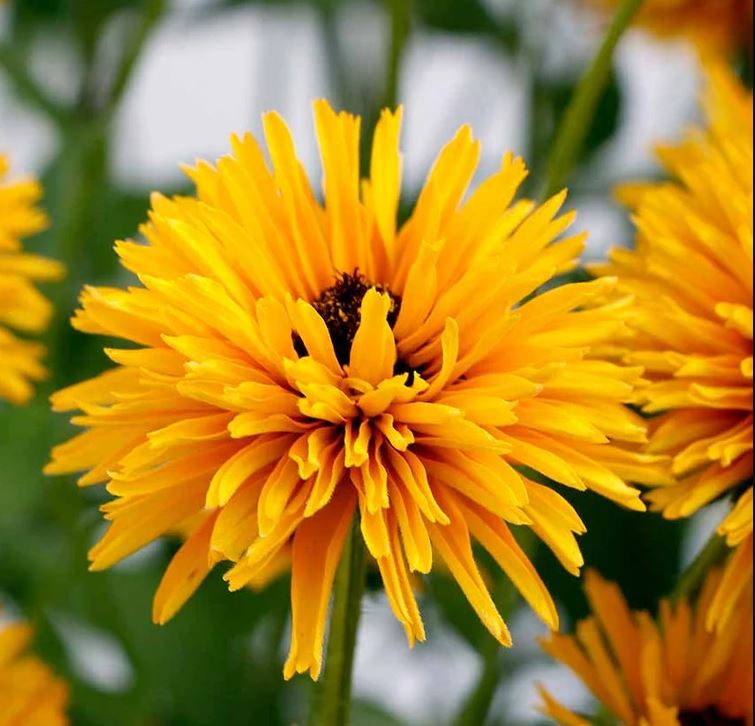Tradescantia
Tradescantias, also known as spiderworts, are a genus of herbaceous perennial plants in the family Commelinaceae. These plants are native to the Americas and are valued for their attractive foliage and colorful flowers. Tradescantias are popular in gardens, as houseplants, and for use in hanging baskets due to their easy care and striking appearance.
The genus Tradescantia includes several species, but the most commonly cultivated ones are Tradescantia zebrina (wandering jew), Tradescantia pallida (purple heart), and Tradescantia fluminensis (small-leaf spiderwort). These plants are characterized by their succulent, trailing stems and vibrant leaves.
Tradescantias typically have elongated, lance-shaped leaves that come in various shades of green, purple, silver, or variegated combinations. The leaves may have distinct patterns or stripes, adding to their ornamental appeal. Some species also produce small, three-petaled flowers in shades of white, pink, or purple.
These plants are adaptable and can tolerate a wide range of growing conditions. They prefer bright, indirect light but can also handle some shade. Tradescantias thrive in well-draining soil and require regular watering, allowing the soil to dry slightly between waterings.
Tradescantias are known for their vigorous growth and ability to spread rapidly. In some regions, they can even become invasive if not properly managed. However, they are also valued for their ability to cover and beautify spaces quickly.
Tradescantia Family
The Tradescantia family, or the family Commelinaceae, is a diverse plant family that includes numerous genera and species. As of September 2021, the Commelinaceae family consists of approximately 40 genera and over 800 recognized species.
Tradescantia is one of the well-known and widely cultivated genera within the family, but there are many other genera that belong to the Commelinaceae family, such as Commelina, Callisia, Rhoeo, Cyanotis, and Gibasis, as mentioned earlier.
Here are some notable plants within the Commelinaceae family:
- Commelina: This genus includes species such as Commelina communis (Asiatic dayflower) and Commelina erecta (whitemouth dayflower). They are herbaceous perennials with blue or purple flowers and distinctive triangular-shaped leaves.
- Callisia: Callisia is a genus that encompasses species like Callisia fragrans (inch plant) and Callisia repens (turtle vine). These plants are often cultivated as trailing houseplants, featuring succulent-like leaves and small, inconspicuous flowers.
- Rhoeo: Rhoeo spp., such as Rhoeo discolor (Moses-in-the-cradle), are known for their colorful, sword-shaped leaves with contrasting bands of green, purple, and pink. They are often grown as ornamental plants in gardens or as houseplants.
- Cyanotis: Cyanotis somaliensis (kitten ears) is a popular houseplant in the Commelinaceae family. It has fuzzy, silver-gray leaves that resemble cat ears. It is a low-maintenance plant that adds a touch of uniqueness to indoor spaces.
- Gibasis: Gibasis geniculata (Tahitian bridal veil) is a delicate trailing plant with thin, cascading stems and small white flowers. It is often grown in hanging baskets or used as a ground cover in warm climates.
More Information
Here’s more information about Tradescantia plants:
- Appearance: Tradescantia plants typically have long, trailing or upright stems that can be either succulent or herbaceous, depending on the species. The leaves are often elongated, lance-shaped, and arranged alternately along the stem. The leaf coloration varies among species and can range from various shades of green to purple, silver, or variegated patterns.
- Flowers: Tradescantia plants produce small, three-petaled flowers that are often clustered together in inflorescences. The flowers can come in different colors, including white, pink, purple, and blue. The blooms are typically short-lived but can be quite showy when in full bloom.
- Popular Species: Some of the commonly cultivated Tradescantia species include:
- Tradescantia zebrina (Wandering Jew): Known for its trailing stems with silver stripes on the upper surface of the leaves and purple undersides.
- Tradescantia pallida (Purple Heart): Features purple foliage that intensifies under bright light and produces small pink flowers.
- Tradescantia fluminensis (Small-leaf Spiderwort): Exhibits small, ovate leaves with green or variegated patterns and produces white flowers.
- Cultivation: Tradescantia plants are generally easy to grow and care for. They prefer bright, indirect light but can tolerate some shade. They thrive in well-draining soil and appreciate regular watering, allowing the soil to slightly dry out between waterings. Tradescantias can be propagated through stem cuttings or division, making them easy to propagate and share with others.
- Versatility: Tradescantia plants are versatile and can be used in various settings. They can be grown outdoors in gardens as ground covers, in borders, or in containers. They are also popular as indoor plants, particularly in hanging baskets, where their trailing growth habit is showcased. Tradescantias can add a touch of color and texture to both indoor and outdoor spaces.
- Care Considerations: While Tradescantias are generally low-maintenance, a few considerations include:
- Protecting them from harsh direct sunlight, which can scorch their leaves.
- Avoiding overwatering, as excessively wet soil can lead to root rot.
- Monitoring for pests such as spider mites and aphids, which can occasionally affect these plants.
Tradescantias are prized for their striking appearance, adaptability to different environments, and ease of care, making them popular choices among plant enthusiasts and beginners alike.





